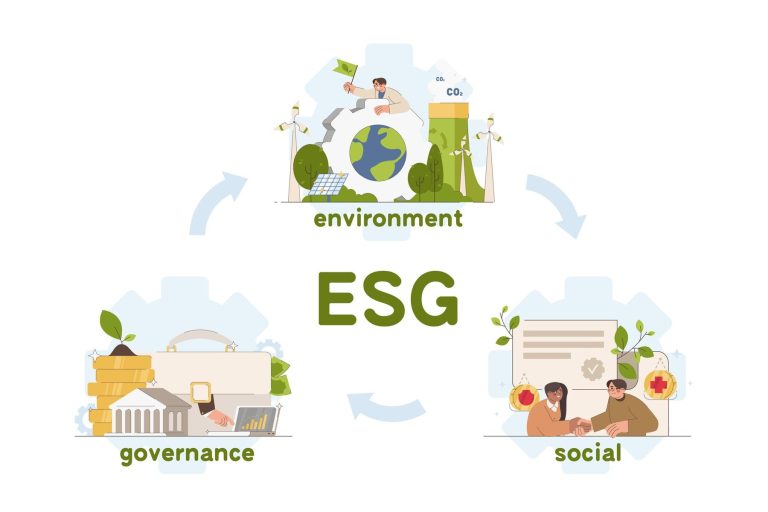The global movement towards responsible investing has made ESG factors more important in retirement portfolios. ESG investing adds environmental, social, and governance aspects to the investment decision process. This helps retirees and other investors find ethical and sustainable options while still aiming for financial returns. In uncertain market conditions, ESG-based portfolios are becoming new ways to connect investment goals with progress in society. As more of these opportunities arise, people are finding ways to achieve both financial stability and a positive impact on their surroundings.
Understanding ESG Fundamentals
Environmental, social, and governance (ESG) principles are key to sustainable investing and ESG investing. They give a new way to look at investment opportunities. ESG funds focus on companies that do well with issues like climate change, fair labor practices, and clear governance to manage risks and achieve long-term financial goals.
When investors learn about ESG ratings, they can better judge how companies handle these issues compared to others in the same field. This framework helps in making responsible investing choices and setting specific objectives for responsible investment. It also allows investors to play a part in creating positive societal change through their money decisions.

Defining ESG: What Does It Stand For?
ESG means environmental, social, and governance. This is a set of criteria that helps to check how safe and responsible an investment is. These criteria look at many issues like carbon emissions, renewable energy, and corporate governance. ESG funds use these measures to pick companies that follow good ethical principles and perform well.
For example, environmental factors show how a company takes care of natural resources. This includes checking their energy efficiency and waste management. Social factors explore how organizations handle social justice, as well as the health of their workers and the happiness of their customers. Governance focuses on the diversity of leaders, as well as how transparent and responsible companies are.
Using ESG ratings helps investors look at how well companies can make profits while also following ethical standards. Companies with high scores are better at handling extra risks during uncertain market conditions. This makes ESG investing a great way to gain sustainable financial returns and support meaningful causes.
The Importance of Each ESG Component
Understanding the different roles of environmental, social, and governance parts is important for investors. Here’s a look at what each part focuses on:
Component | Key Focus |
|---|---|
Environmental | Climate change, energy efficiency, renewable energy, greenhouse gas emissions |
Social | Employee diversity, human rights, customer satisfaction, social justice |
Governance | Executive pay, corporate accountability, board diversity, corporate transparency |
Fighting climate change and pushing for renewable energy are key factors in the environmental side of ESG investing. Companies that lead in being eco-friendly usually attract ESG investors who want to help solve the global carbon emissions crisis.
The social part focuses on the well-being of everyone involved. It looks at things like workplace equality and human rights. Good social practices can strengthen a business in the long run. Governance brings in the idea of strong leadership. It makes sure that companies are open and accountable, helping to build trust with investors.
Why ESG is Gaining Popularity Among Retirees
Traditionally, retirees focused on minimizing risk and maximizing income in their portfolios. But today’s retirees are increasingly interested in investing with purpose. Here’s why ESG is becoming more appealing:
1. Alignment with Personal Values
Many investors want their money to reflect their values. ESG investing allows retirees to support causes they care about—whether it’s climate action, social justice, or corporate transparency.
2. Growing Evidence of Competitive Returns
Contrary to the myth that ESG investing sacrifices returns, numerous studies have shown that ESG-aligned portfolios can perform on par with—or even outperform—traditional investments over the long term.
3. Better Risk Management
Companies with strong ESG practices tend to manage risk more effectively, making them more resilient in times of crisis. For retirees who want stability, this can be an added benefit.
How to Incorporate ESG Into Your Retirement Strategy
ESG investing doesn’t require a complete overhaul of your portfolio. Here are several ways to get started:
1. Review Your Current Holdings
Work with a financial advisor to assess the ESG scores of your current investments. Tools and ratings from MSCI, Sustainalytics, and Morningstar can help.
2. Invest in ESG Funds
Many mutual funds and ETFs now focus exclusively on ESG criteria. These funds provide broad market exposure while filtering companies based on ESG performance.
3. Customize Your Approach
Some retirees prefer to focus on specific causes—such as clean energy or gender equality. A customized ESG strategy can reflect these personal priorities.
4. Stay Diversified
As with any investment strategy, diversification is key. ESG investing should still reflect sound asset allocation across sectors, geographies, and risk levels.
Final Thoughts: Is ESG Right for Your Retirement?
ESG investing represents a meaningful shift in how people think about money and impact. For retirees, it offers the chance to support a better future while securing their own. The key is finding the right balance between values and financial needs.
Let Goldstone Help You Align Your Values with Your Investments
At Goldstone Financial Group, we specialize in retirement planning that reflects both your financial goals and personal values. Whether you’re just exploring ESG investing or ready to build a fully aligned portfolio, our experienced advisors are here to help.
Schedule a complimentary consultation today and discover how ESG principles can enhance your retirement strategy—without compromising on performance or peace of mind.



